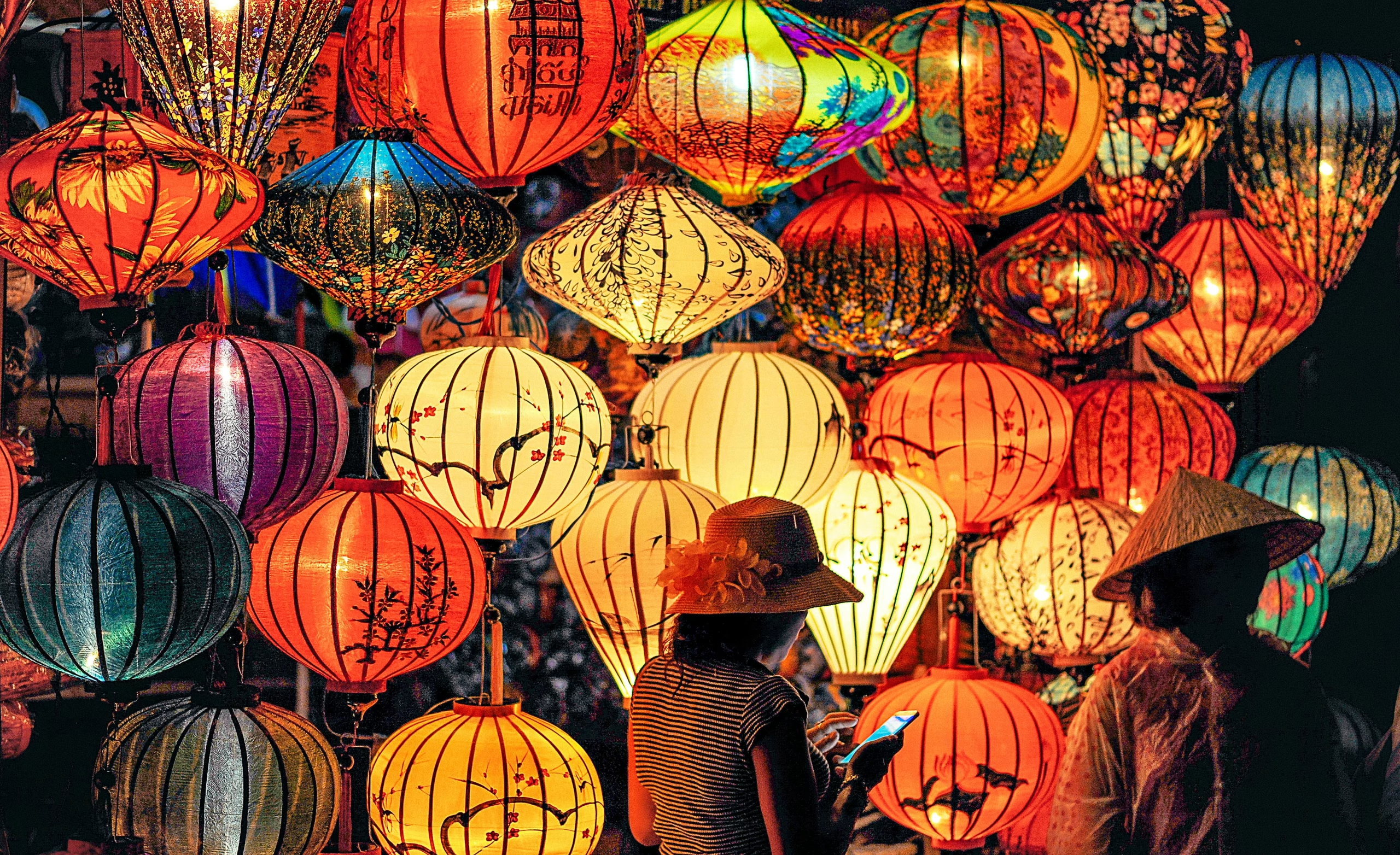Lantern Festivals Around the World 2025: A Global Celebration Guide

Lantern festivals have been a part of cultural celebrations for centuries, capturing the imaginations of people across the globe. From the traditional Chinese Lantern Festival on February 12, 2025, where vibrant lanterns light up the sky to celebrate unity and the coming of spring, to the serene glow of floating lanterns in Hoi An, these events create unforgettable experiences. Such festivals not only symbolize hope and renewal but also offer a unique blend of cultural performances, delicious food, and artistic displays.
Travelers can find themselves enchanted by the RISE Festival in the Mojave Desert, renowned as the world’s largest sky lantern event. It combines art, music, and light in a magical setting, offering a truly immersive experience. Meanwhile, in Albuquerque, the Light The Night event invites attendees to embrace a world of love and laughter beneath a sky filled with floating lights. Whether dancing under illuminated skies in Vietnam or observing intricate designs in China, these festivals are a testament to the universal allure of light and tradition.
The beauty of lantern festivals goes beyond their dazzling visual displays. These events serve as a reminder of shared histories and cultures, drawing people together in celebration. By exploring these festivals in 2025, visitors gain insight and appreciation for the rich tapestry of global traditions. Whether you’re looking to experience cultural diversity, enjoy festive cuisine, or simply be part of a breathtaking spectacle, lantern festivals around the world offer something special for everyone.
Historical Significance of Lantern Festivals
Lantern festivals are celebrated worldwide, each showcasing its unique history and cultural significance. These festivals often symbolize community, hope, and the triumph of light over darkness.
Origins and Evolution
Lantern festivals trace back over 2,000 years, originating during the Han Dynasty in China. Traditionally held on the 15th day of the first lunar month, they mark the end of Chinese New Year celebrations and the first full moon of the lunar year.
Initially, the lanterns were simple, used by Buddhist monks to honor the Buddha. Over time, they became more intricate and decorative, evolving into widespread celebrations that include artistic displays, dance performances, and parades. These changes reflect the shifting cultural and social landscapes through the centuries.
Key Historical Periods:
- Han Dynasty: Initial religious significance
- Tang and Song Dynasties: Artistic and cultural expansion
- Modern Era: Global influence and adaptations
Cultural Importance
The cultural importance of lantern festivals spans various regions in Asia and beyond. In China, they represent family reunion and social harmony. Lantern riddles, traditional foods, and dragon dances are common, engaging community members in shared activities. This fosters reconciliation, peace, and togetherness.
In Vietnam, the Full Moon Lantern Festival takes place monthly in Hoi An, emphasizing the local heritage and the significance of the lunar cycle. In other parts of the world, lantern festivals have adapted to commemorate unique cultural narratives, whether honoring ancestors or celebrating environmental elements.
These festivals continue to play a vital role in cultural preservation, serving as both a reflection of traditional values and a platform for artistic and social expression.
Major Lantern Festivals in Asia
Lantern festivals in Asia are vibrant celebrations full of tradition and beauty. They often coincide with lunar events and light up the night sky with countless glowing lanterns. Each festival has its unique customs and significance, drawing visitors from around the world.
Yi Peng and Loy Krathong in Thailand
In Thailand, Yi Peng and Loy Krathong are celebrated every year with great enthusiasm. Yi Peng is known for the spectacle of thousands of lanterns floating into the sky in Chiang Mai, creating a breathtaking sea of lights during November. Participants release khom loi, or sky lanterns, which symbolize letting go of worries.
Loy Krathong complements Yi Peng by celebrating on water. Participants float lotus-shaped baskets, or krathongs, decorated with flowers and candles on rivers. This symbolizes paying respect to the goddess of water. Together, these festivals attract huge crowds, offering a magical and heartwarming experience. More information can be found about the Yi Peng Festival on Asia Highlights.
As thousands of lanterns light up the sky in Chiang Mai, make sure you stay connected by using a local eSIM from Telekonek. With our easy-to-install eSIM, you can access reliable mobile data to share your magical festival moments with friends and family instantly.
Mid-Autumn Festival in China
The Mid-Autumn Festival is a major celebration in China, held on the 15th day of the 8th lunar month. This festival marks the harvest season and is closely tied to the legend of Chang’e, the moon goddess. Lanterns of various shapes and sizes light up homes, streets, and parks.
Families gather to admire the full moon and enjoy mooncakes, a traditional delicacy filled with lotus seed paste or red bean. Lantern riddles are also part of the celebration, adding a fun activity for families and communities.
Lantern displays are often elaborate, featuring intricate designs that depict stories and showcase Chinese culture. The Mid-Autumn Festival creates a joyous atmosphere, bringing people together in appreciation of the moonlight.
For travelers heading to China for the Mid-Autumn Festival, staying connected is essential. Install a China eSIM from Telekonek to enjoy uninterrupted access to navigation, social media, and travel apps while admiring the moonlit lantern displays.
Lantern Festival in Taiwan
Taiwan’s Lantern Festival is an extension of the Chinese New Year celebrations and occurs on the 15th day of the first lunar month. Known for its grand lantern exhibitions, the festival includes traditional folk performances, fireworks, and lantern-making workshops.
One of the highlights is the releasing of sky lanterns in locations like Pingxi District. Participants write wishes on the lanterns before releasing them, hoping for good fortune in the coming year. Additionally, large-scale lantern displays often include themes that promote local culture and environmental awareness.
The festival attracts both locals and international tourists, creating a vibrant and festive atmosphere throughout Taiwan.
As you experience the awe-inspiring lantern releases in Pingxi, don’t worry about finding Wi-Fi. Telekonek’s Taiwan eSIM offers fast and easy mobile connectivity, perfect for staying connected during your travels.
Lantern Festivals in Europe
Europe hosts a variety of lantern festivals that showcase both traditional and contemporary art forms. Key events include the vibrant Fête des Lumières in France and the enchanting Florence Light Festival in Italy.
Fête des Lumières in France
The Fête des Lumières is an annual event in Lyon, France. Known for its unique light displays, the festival transforms the entire city into a glowing art canvas. The origins trace back to 1852, when locals began putting candles in their windows to honor the Virgin Mary.
Held every December, the event attracts millions of visitors. Artists from around the world create intricate installations that light up buildings, streets, and squares. The festival features a range of activities, from parades to interactive displays, providing something for everyone to enjoy.
Visitors are advised to book accommodations well in advance due to the festival’s popularity. Public transportation is recommended, as roads often close to accommodate foot traffic. The Fête des Lumières is not only a cultural phenomenon but also a significant boost to Lyon’s tourism and local economy.
Capture the stunning light displays in Lyon while staying online with Telekonek’s France eSIM. Our eSIM service lets you navigate the city, share photos, and access festival schedules without the hassle of roaming charges.
Florence Light Festival in Italy
Florence hosts the Florence Light Festival, also known as F-Light. This stunning event uses the city’s historical architecture as a backdrop for modern light art. Held in December, the festival aims to highlight the artistic heritage of Florence through innovative light displays.
Monuments such as the Ponte Vecchio and Palazzo Vecchio serve as canvases for these projections. The festival combines traditional Florentine artistry with modern techniques, creating a unique spectacle. Besides light displays, the event features workshops and educational activities.
Attendees can wander through streets filled with mesmerizing installations. The festival is family-friendly and provides an opportunity for both locals and tourists to experience the city’s rich culture. F-Light is a testament to Florence’s enduring legacy as a center of art and creativity.
While you marvel at the artistic light projections in Florence, ensure seamless internet access with Telekonek’s Italy eSIM. Share your festival experience with the world, or look up recommendations for nearby dining spots, all with a reliable connection.
Celebrations in the Americas
Lantern festivals in the Americas offer a captivating blend of tradition and innovation, drawing people with spectacular displays and unique cultural experiences. In the United States, the Rise Lantern Festival stands out for its massive sky lantern release and lively entertainment. Meanwhile, Canada’s Luminara creates an enchanting atmosphere with vibrant lights and community involvement.
Rise Lantern Festival in the United States
The Rise Lantern Festival is held in the Mojave Desert and is renowned for being the world’s largest sky lantern festival. Attendees gather to release thousands of lanterns into the night sky, creating a breathtaking visual spectacle. Each lantern carries personal wishes and hopes, making the event both personal and communal.
Music and art are also integral parts of the festival. In celebration of their 10th anniversary, the musical lineup has been significantly expanded, featuring talented artists from around the globe. Festivalgoers can enjoy a mix of performances while participating in the lantern release. Safety is a priority, with the event organizers considering weather conditions to ensure the safe and legal release of lanterns.
Attending the world’s largest sky lantern release in the Mojave Desert? With Telekonek’s USA eSIM, you’ll always stay connected, whether you need directions, want to stream music, or share your festival moments on the go.
Luminara in Canada
Luminara in Canada offers a different but equally enchanting experience. Known for lighting up communities, it brings together people of all ages. Participants create beautifully decorated lanterns, adding a personal touch to the festival. The event fosters creativity and inclusiveness, showcasing the artistry of those involved.
Community engagement is a core element of Luminara. Families and friends come together to enjoy the lights, music, and creative workshops. The event often supports local artists and musicians, adding to the vibrant cultural display. Luminara is not just a spectacle but a celebration of community spirit and collective joy, with its lights brightening up the evening sky.
Make sure you don’t miss any part of the mesmerizing Luminara festival in Canada. Use Telekonek’s Canada eSIM for uninterrupted mobile service, allowing you to post real-time updates and keep in touch with loved ones.
Lantern Displays and Artistry
Lantern festivals in 2025 showcase an incredible variety of artistic displays, blending cultural traditions with modern design. This section explores the intricate craftsmanship and innovative sustainable practices that feature prominently in lantern artistry.
Design and Craftsmanship
The design and craftsmanship of lanterns are central to the beauty of these festivals. Each lantern is a unique piece of art, often portraying elements from folklore, nature, or historical themes. Artists use vibrant colors and intricate patterns to capture the viewer’s attention.
Handmade lanterns are often crafted using traditional techniques passed down through generations. Materials like paper, silk, and bamboo are popular choices, allowing for flexibility and durability. In countries like Thailand, Loy Krathong and Yi Peng feature floating and flying lanterns that create stunning visual effects.
Lighting plays a crucial role in the design process, using LED lights for vivid illumination. This not only enhances the visual impact but also conserves energy. The artistry of lantern design reflects both deep cultural roots and modern artistic expressions.
Sustainability Innovations
Lantern festivals are increasingly embracing sustainability by integrating eco-friendly practices into their celebrations. Artists and organizers are working on reducing waste and conserving resources without sacrificing the festival’s visual allure. Biodegradable materials have become popular in lantern creation, offering an environmentally friendly alternative to traditional materials.
Solar-powered lanterns are another innovation, reducing electricity consumption and promoting renewable energy. These lanterns draw energy from the sun during the day and light up at night, providing a sustainable solution.
Efforts to minimize pollution, like implementing controlled release guidelines, are crucial. For instance, Sky Lantern Festivals require specific weather conditions to ensure safe launches, protecting both the environment and local wildlife. These advancements help ensure that the festivals not only celebrate cultural heritage but also contribute positively to environmental conservation.
Ceremonial Practices and Performances
Lantern festivals around the world showcase a variety of ceremonial practices and performances. These events often feature traditional music and dance that highlight cultural heritage, while modern interpretations bring fresh perspectives through innovative displays.
Traditional Music and Dance
Many lantern festivals incorporate traditional music and dance, which play a central role in celebrating cultural identity. In the Yi Peng Lantern Festival in Chiang Mai, for example, music and dance performances are integral to the vibrant atmosphere. Local artists perform folk dances, dressed in colorful traditional attire. The melodies played during these events are usually created with local instruments, which help set a festive mood.
The Hoi An Lantern Festival in Vietnam is also known for its traditional ambiance. The absence of electric lights creates an authentic setting for storytelling through dance. Performers often depict historical tales, sharing the region’s history with attendees. Such performances are a way for communities to pass down traditions and ensure cultural continuity.
Modern Interpretations and Displays
Modern interpretations of lantern festivals often feature creative displays that attract visitors of all ages. New technologies, such as LED lights and digital projections, enhance the visual experience. In addition to traditional elements, festivals now incorporate these innovations to offer a more dynamic experience.
Some festivals showcase performances that blend contemporary music with digital art installations. This fusion allows visitors to experience a lively mix of the old and the new. Interactive displays are popular as well, inviting attendees to engage with the art in unique ways. Modern elements ensure that lantern festivals continue to evolve while preserving their cultural significance.
Technological Advancements in Lantern Festivals
In recent years, lantern festivals have evolved to include cutting-edge technology that enhances the visual experience. Two key innovations in this evolution are the integration of LED lighting and the use of interactive installations.
LED Integration
LED lights have transformed traditional lantern festivals by allowing for brighter and more vivid displays. Unlike traditional bulbs, LEDs consume less energy and offer a wider range of colors. This makes them ideal for creating intricate patterns and animated sequences on lanterns.
In addition to being energy-efficient, LEDs can be programmed to sync with music, providing a synchronized light and sound show. This feature adds a modern twist to the festival, captivating audiences with dynamic performances. For example, some events incorporate LED-lit lanterns that change colors and patterns throughout the evening. These adaptations not only preserve the beauty of the lanterns but also introduce new artistic possibilities.
Interactive Installations
Interactive installations are enhancing visitor engagement at lantern festivals. These installations often involve using technology such as sensors or motion detectors, allowing attendees to interact directly with lanterns. For instance, some setups allow visitors to change the colors or patterns of a lantern by waving their hands or using a mobile app.
Such innovations create a personalized experience by letting individuals play a part in the display. Visitors find it exciting to have a direct impact on the radiant artwork surrounding them. In Taiwan, for instance, interactive elements have become a popular addition, providing a unique and immersive experience for festival-goers.
Economic Impact of Lantern Festivals
Lantern festivals are more than just colorful and cultural events. These festivals significantly benefit local tourism and contribute to the global market for festival-related goods.
Tourism and Local Economies
Lantern festivals attract thousands of visitors, boosting tourism and generating income for local economies. During events like the Chinese Lantern Festival, hotels, restaurants, and shops see increased traffic. Visitors spend money on accommodations, food, and souvenirs, leading to revenue growth for businesses.
Moreover, these festivals often create temporary jobs in hospitality and entertainment sectors. Organizers, vendors, and performers benefit from additional work opportunities, strengthening the local job market. This influx of visitors not only supports immediate economic growth but also promotes cultural exchange and fosters community pride.
Global Market for Festival Goods
The demand for festival goods like lanterns, decorative materials, and traditional costumes contributes to a thriving global market. Manufacturers and artisans see increased orders before major festivals, supporting craft industries in regions like China and Thailand. The Loy Krathong and Yi Peng festivals in Thailand showcase unique cultural products.
Exports of lantern-making materials boost international trade. Retailers worldwide stock themed goods to meet global interest. By engaging in fair trade practices, producers ensure sustainable production while supporting local artisans. The global market responds with diverse, quality products that enhance cultural celebrations across continents.
Lantern Festival Planning and Logistics
Planning a lantern festival requires attention to organization, safety, permits, and legal considerations. Organizers must ensure a smooth and safe event for all participants while complying with local regulations.
Organization and Safety
Effective organization is key to ensuring a successful lantern festival. Event planners must consider crowd management and emergency preparedness. This involves designating clear entry and exit points and having first aid stations readily available. It’s important to coordinate with local authorities like police and fire departments to develop a robust safety plan.
Safety is crucial when dealing with lanterns that have live flames. Organizers should use fire-retardant materials and provide information to attendees about safe lighting and release practices. Regular training sessions for volunteers and staff can mitigate accident risks during the event.
Permits and Legal Considerations
Obtaining the necessary permits is a fundamental step in planning a lantern festival. Organizers must consult with local government bodies to understand the specific requirements. These can include permits for land use, fire safety, and public gatherings.
Compliance with environmental laws is essential, especially when an event involves releasing lanterns into the sky or water. Understanding legal responsibilities helps prevent penalties. Checking local ordinances ensures that the use of lanterns is permissible and that waste management plans are in place to protect the environment.
Cultural Exchange and International Collaboration
Lantern festivals foster cultural exchange by bringing together people from various backgrounds to celebrate traditional arts and crafts. These events often feature colorful parades, traditional music, and dance performances. Visitors get a unique opportunity to experience cultural diversity firsthand.
International collaboration is essential in organizing large-scale lantern festivals. For example, the Lantern Festival in Taiwan attracts artists and tourists worldwide. This requires collaboration between local authorities, international artists, and tourism boards to ensure successful events.
A key element of these festivals is the exchange of ideas and artistry. Artists from different countries contribute their expertise, resulting in innovative and diverse lantern designs. This collaboration nurtures creativity and mutual appreciation for different art forms.
Participants often engage in workshops and cultural programs, allowing them to learn new skills and traditions. These activities encourage an appreciation for the shared history and values among different cultures.
Moreover, lantern festivals serve as platforms for community building. They create opportunities for locals and visitors to interact, fostering friendships and understanding across cultural boundaries. This interaction promotes a sense of global community.
In summary, lantern festivals play a crucial role in promoting cultural exchange and international collaboration. They offer a unique blend of art, tradition, and community engagement that enriches the lives of participants and fosters global connections.
Challenges and Controversies
Lantern festivals are celebrated globally, but they also face challenges and controversies, particularly environmental concerns and cultural appropriation debates. These issues are significant and impact how these events are perceived and organized.
Environmental Concerns
Releasing sky lanterns can pose environmental risks. The lanterns, often made of paper and wire frames, can fall into forests, oceans, or urban areas, creating litter and potential hazards for wildlife. The risks are not only physical debris but also the potential for starting fires.
Wind speed and other weather conditions must be carefully monitored to prevent lanterns from going astray. Events are sometimes canceled or rescheduled to avoid accidents. Advocates for the environment push for lanterns made from biodegradable materials, highlighting the importance of reducing the negative impact on nature while maintaining traditional celebrations.
Cultural Appropriation Debates
Lantern festivals originate from specific cultural traditions, particularly in Asian societies. As these events grow in popularity worldwide, there’s a debate on cultural appropriation. Concerns arise when the festivals’ cultural significance is overshadowed by commercial interests in non-native regions.
Respectful representation requires understanding the history and traditions behind these festivals. Organizers in different countries often collaborate with cultural groups to ensure authenticity and respect, balancing local adaptations with global interest. This collaboration helps maintain the integrity of lantern festivals and encourages an appreciation of the culture from which they originate.
The Future of Lantern Festivals
As lantern festivals evolve, new trends and innovations shape their future, enhancing cultural experiences. These events also increasingly emphasize community involvement and education. The combination of technology and tradition plays a vital role, while fostering a sense of connection and learning among participants.
Innovation and Trends
Lantern festivals are embracing cutting-edge technology to enhance visitor experiences. LED lights and interactive displays are becoming popular, allowing vibrant and dynamic exhibits. Some festivals incorporate augmented reality to create engaging and immersive environments. These innovations not only captivate attendees but also help tell cultural stories in new ways.
Sustainability is a growing focus, with eco-friendly materials and solar-powered lanterns gaining attention. This shift towards greener practices reflects a broader awareness and responsibility toward the environment. Online platforms extend the reach of these festivals, as virtual tours and live streaming enable global participation. This blend of technology ensures lantern festivals remain relevant and exciting for future generations.
Community and Educational Aspects
Community involvement is central to the evolution of lantern festivals. Local artists and craftsmen often collaborate to design unique lanterns, promoting cultural exchange and preserving traditional skills. Workshops and classes offer hands-on experiences, educating attendees on the intricacies of lantern making and the historical significance of the events.
Educational programs increasingly accompany these festivals, targeting schools and families. These initiatives provide valuable lessons on cultural heritage, fostering appreciation and understanding among younger audiences. By engaging local communities and providing educational opportunities, lantern festivals cultivate a sense of belonging and cultural identity. As these traditions continue to grow, they maintain their role as a vibrant platform for learning and cultural expression.


